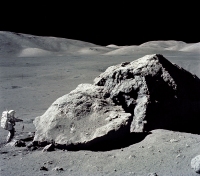
September Editorial
Where are the moon rocks?

September Editorial
Where are the moon rocks?
|
Moon rocks are rare - much rarer than diamonds. As rocks there is nothing special about them, and they are far from the only rocks that have come from beyond the planet earth, as many meteorite collections will show. However the fact that collecting these rocks involved a tripof over half a million miles to earth's satellite makes these rocks special. And as the last moon mission was over thirty years ago, these rocks have become even more special. Yet many have simply vanished, misplaced through carelessness, sloppy administration or during upheavals of various kinds.
|
The first moon rocks were collected by NASA's astronauts during the Apollo 11 mission to the Moon in 1969 and more in the Apollo 17 mission three years later. Many of these rocks (approximately 270 from the Apollo 11 mission and 134 from the Apollo 17 mission) were given as gifts to foreign countries by the Nixon administration. | |
|
An Apollo 11 gift rock typically weighs just 0.05 grams - the size of a grain of rice. The Apollo 17 gift rocks are slightly larger and weigh about 1.1 grams. Both are encased in plastic globes to protect them and make easier to view. Generally, tthese gift samples ended up being stored in the vault of a national museum and often are not even on public display. In fact most people were unaware of the issue of moon rocks in museums until last month when a Dutch museum (the Rijksmuseum) announced that the moon rock which they had received in 1992 from the estate of the late Prime Minister Willem Drees was a fake. After testing the rock, the museum discovered that it was a piece of petrified wood, possibly from Arizona. Before going further we should point out that the family of late Prime Minister Willem Drees was never trying to mislead the Rijksmuseum. A US ambassador gave Drees the rock on Oct. 9, 1969 during visit to the Netherlands by the Apollo 11 astronauts. The plaque attached to the stone does not state that it is a Moon rock. However, the rock, which weighs approximately 89 grams, was confused a with moon rock which the Dutch were given at the same time and which, after investigation, was found on display elsewhere in a natural history museum. It seems that Willem Drees formed a mistaken opinion that the rock which he had been given was the moon rock, a belief which the family never questioned. After his death they donated the rock to the museum in good faith. The mis-identification, and the subsequent media fuss raised questions about how well other countries have safeguarded their lunar treasures. On the face of it, it seems that for many countries, the answer is 'not that well'. Several nations (for example Ecuador and Cyprus) seemed unaware that they had ever been given the rocks. Other moon rocks have certainly been lost or stolen. For example, five rocks were handed to African dictators now long since dead or deposed and finding those rocks is almost an impossible task. Although from the mineral point of view the moon rocks are worthless, they are a real treasures for collectors and fetch a very high price on the black market. Joseph Gutheinz, a former US investigator now with the University of Arizona, recalls the case of a moon rock which was stolen in Honduras and ended up on the black market with an asking price of $5 million. The rock was recovered and eventually returned to Honduras after a lengthy legal process in Florida District court. This case is sadly not unique. Although for the general public this story may be new, it is certainly not for experts who have been trying a number of years now to trace the missing moon rocks and compile a list of the current whereabouts of all the others. It is a difficult project. For a start, NASA originally handed over the rocks to the US State Department. Thereafter they had no influence or subsequent information about when and to whom the rocks were given. According to Tiffany Hamelin, the State Department historian, there is not even an official list of who received the rocks. That may sound strange or even careless to us now, but when Apollo 11 returned from the moon, everyone thought that lunar missions would become increasingly common, and the presence of lunar rocks on earth equally common. So at that time the rocks were more souvenirs of the historic Apollo 11 mission than a gift of extremely rare rocks. After all everyone thought that there would soon be plenty more where those came from. A generation later, we know that is not the case. So finding and cataloguing the original moon rocks has become more urgent. Out of the 134 Apollo 17 moon rocks handed out to other nations, so far the whereabouts of only 30 has been definitely established. Romania's rock disappeared in 1989 after the fall and execution of Nicolae Ceausescu. Pakistan's, Nicaragua's and Afghanistan's rocks are missing. the Spanish rock has apparently been lost and Malta's rock was stolen in 2004. Today there are only a few countries, these being Britain, Australia, Canada and New Zealand and Netherlands which can account for both their Apollo 11 and their Apollo 17 moon rocks. It is beginning to look as if finding all the missing rocks is less easy than going to the moon to get some more. | |
| _______________________________ | ||||
| Home | | | Shopping | | | Database |
© Biscuit Software 2004-2015
All rights reserved